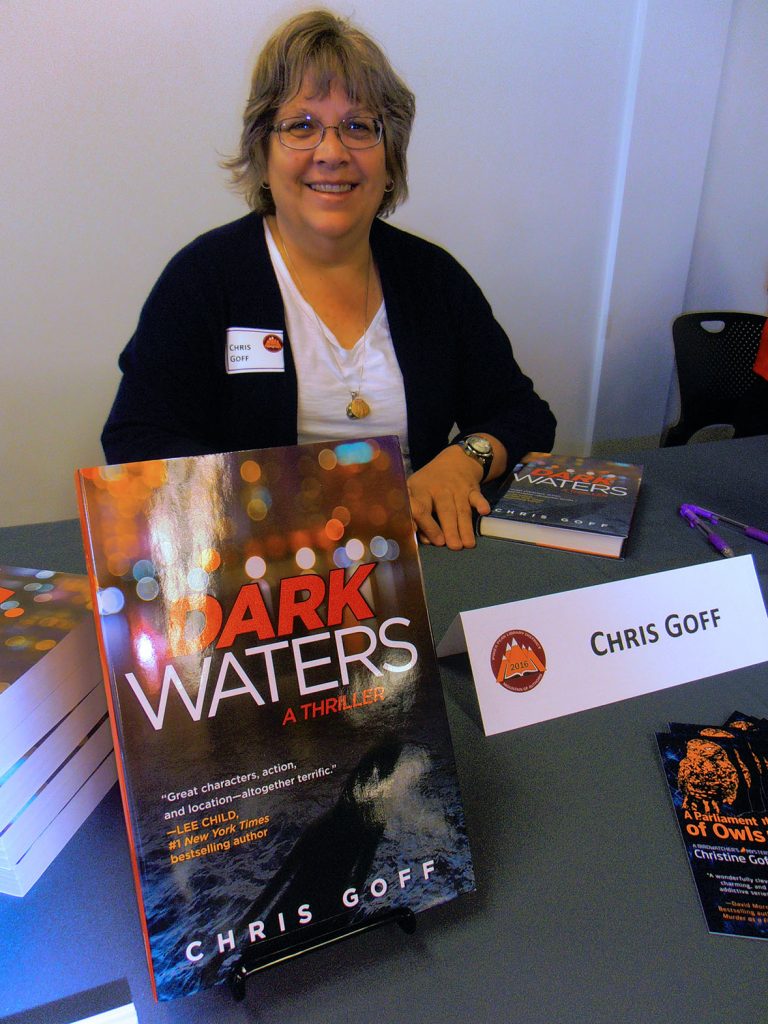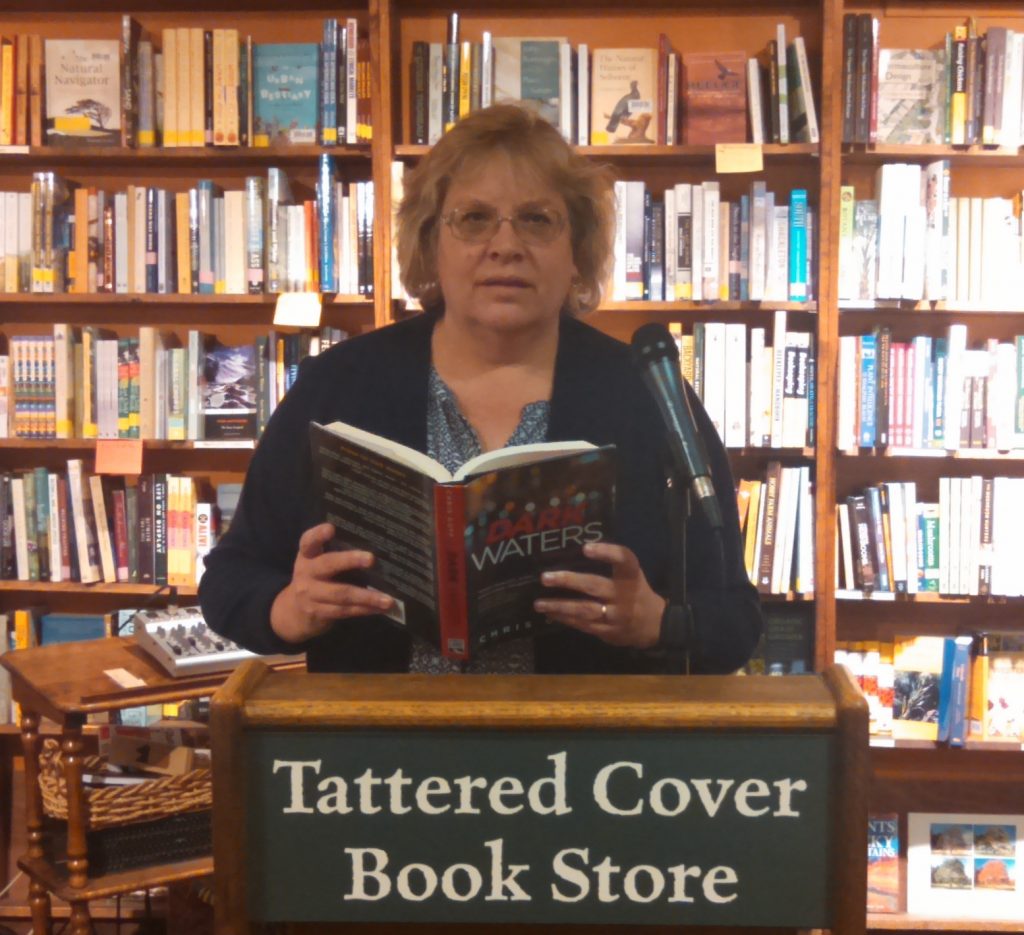The Art of Going Deep: Part II
By Chris Goff
In Part I, I talked about digging DEEP to find the BIG concept, the right Point of View, and getting to know your characters. So, how do you get into your character’s head?
Use your own experiences.
Thomas Harris in Silence of the Lambs gave us two characters: Jame Gumb and Hannibal Lector. Both suffered from abusive childhoods, manifesting themselves in different ways. Was Thomas Harris abused as a kid? I have no idea. I wasn’t, and yet I could relate. I know people who suffered abuse, grew up in alcoholic environments. None of them grew up to be serial killers, but it colored how they view the world.

Everyone cries. Totally acceptable when hurt, at funerals, sad movies, and weddings. But I cry when I’m mad. Not the most effective way to get my point across when I’m angry. It takes the bite out of a good tongue lashing. But I can effectively tap that emotion when I want my character to feel humiliated.
Ever been kidnapped? Me neither. But I know what it feels like to turn away for two minutes, then turn back around to find your child gone. The fear that something horrible has happened is paralyzing, traumatizing, and—in my case, lasted all of two minutes. Then I heard my name blaring over the store’s loudspeaker summoning me to Customer Service where I found my little angel sitting on the counter licking a Tootsie Roll Pop. Still, the fear sticks with me.
In my book, DARK WATERS, I have a scene where my protagonist, Raisa Jordan, goes to the home of a widow following a burial and is ordered to leave. The woman is Hasid, a member of a sub-group of Ultra-Orthodox Judaism. Raisa is not Jewish, and she is unwelcome because of her collegial relationship to the widow’s late husband. As Raisa leaves, she is threatened by a group of men outside, who spit at her and throw stones. Terrifying, and like something I experienced with my eleven-year-old daughter after getting lost riding a bus in Tel Aviv and ending up in Bnei Brak.
Bottom line, we’ve all experienced life events that we can mine for emotion. Dig DEEP enough and you can relate.
Do some research.
Relating to the more dangerous pastimes of your hero or heroine can be a challenge. I have no idea what it feels like to be shot or smothered. And, trust me, I don’t intend to act out these scenarios to write authentically. But I do know how it feels to cut myself with a machete (don’t ask), and to be held under water just a little too long. Then throw in a little research about the stages of drowning: 1-surprise, 2-involuntary breath holding, 3-unconsciousness, 4 and 5-hypoxic convulsions and clinical death. 4 and 5 are not something the victim processes, but another person would. A different POV character would see the victim convulsing, turning blue, and foaming at the mouth.
Going back to Thomas Harris, it’s said he compiled traits of six or seven known serial killers to come up with Buffalo Bill. Interestingly, most of them suffered from “Mommy issues,” as did both villains in Harris’ books. It makes you wonder about Thomas Harris, doesn’t it? Or maybe he was just able to put himself in someone else’s shoes.

Think stereotypes.
All of us use stereotypes. When we meet someone for the first time, we tend to categorize them based on any number of factors: how they dress, how they walk, where they are, who they’re with. We place them in context, and often judge them by the first words out of their mouths.
Suppose your character meets a man for the first time, and he’s wearing a silk shirt with blue jeans. What’s your character’s gut reaction? That the man is cool. That he’s making a fashion statement. Some staid businessman might think the guy’s a punk, thumbing his nose at convention?
Now, in my head, your protagonist was a man. But what if your protagonist is a woman? Will she see this fellow in his silk shirt and blue jeans differently?
Use your imagination.
Trust yourself. Know what it is you want to convey and use your characters to convey just that.

Make the right word choices. How does your hero order coffee? Does he like it black or does he like sugar-ladened, cream-infused concoctions? Does he ask for a cup of coffee, a cup of joe or for java? In my neck of the woods, he asks for java and any local would immediately peg him as a tourist. Where I’m from, we have ranches, not farms. What I call a hill, you’d call a mountain. What I call a lake, you’d call a pond. But beware of dialect. Having a character that says, “ey” or “y’all” in every sentence is bound to wear thin. Same goes with foreign accents.
Show your character’s unique characteristics. Again, tread lightly. To make a character stand out, writers will sometimes give them a quirky characteristic—a tic in one eye, a limp, a mustache twirl. Resist! Often these traits take over and begin to overshadow anything else about the character. Instead, be subtle. Convey your character’s response to stimuli. The smell of bacon will trigger a different response in a carnivore versus a vegetarian. The sound of a door slamming downstairs when someone’s alone in the house will paralyze some and send others into flight mode. Whether we are aware of it or not, in our day-to-day lives we process things through our emotions all the time. Everything triggers an emotional response.
Filter the world through your character’s eyes. Omniscient POV. Third person, third person close, first person. Each one is closer and closer. The further away your POV, the more you need to exercise immersion in your current POV character.
Lose the tags. He said, she said. He growled, she gurgled (okay, tell me none of you would use these last two). When necessary, use: he said, she said. Most readers tend to read past them. But what you really want to do is tie the words to actions or characteristics, something that clues the reader into which character is speaking.

Lose the “filter words.” He noticed. She felt. These words create a gap between the reader and the POV character creating distance and hindering sympathy. “He noticed the clock read twelve.” If we’re in his POV, why not, “The clock on the mantel read twelve.” Instead of “She felt sad,” why not, “Tears blurred her vision.”
Weave emotion through the scene. Infuse emotion in the action and dialogue. “She didn’t want to kill the bastard. He’s the only one who knew where the launch codes were hidden.”
Are there pitfalls?
Yes! You can go too far. Avoid melodrama! There comes a time when a character simply must act, or your prose will be dragged down with purple prose and the weight of a character that wallows in their emotions and reactions. Use details that speak loudly and disperse them. You have a whole book!
Bottom line:
Figure out your characters’ worldview, one shaped by experiences and expectations of self, life, and society. In any given situation, a person, a character brings those aspects to life. How a character will face or describe a given situation and will see each place or predicament will be colored by his worldview. That may be why we’ve all heard the advice, “Write what you know.” If we’re being honest, most of our characters—both the good and the bad—reflect how we see the world, or how we want to see the world. On a final note, Dig DEEPEST in revision. Not as you’re going along. When you’re writing, just write. Dig DEEP and tell your readers your story, the one that only you can tell.
Tell us, Readers, which of your favorite characters are totally immersed in their worldview? Did the author use any of Chris’s techniques above to pull it off?

Chris Goff is the award-winning author of eight novels—six mysteries and two international thrillers. Her books have been finalists for Colorado Book Awards, Colorado Authors’ League Awards and Willa Cather Awards. In 2016, her debut thriller, Dark Waters, was a finalist for the 2016 Anthony Award for Best Crime Audiobook and took home a gold medal from the Military Writer’s Society of America. A former journalist, Goff is a long-standing member of multiple writing organizations and currently serves on the executive board of the International Association of Crime Writers. When not hard at work, she can often be found gallivanting around the world in search of stories and adventure.
















































What a thoughtful blog!!! While I never experienced great fear (or a difficult upbringing) – I do recall that when accepting a potentially dangerous position, I was put through a professional course on danger and hostage-taking….the do’s and don’t’s of reaction (or non-reaction). And Chris’s terrific novels certainly a great example of her research in this sphere.
I would love to have gone through some of your training, and been there for some of your hands-on experiences. It must have been remarkable to have the security clearance you did. Do you still have to keep secrets?
I love deep pov. I’m even down for a little Method sometimes. Like, once, to get at what my lost in the wilderness heroine experienced when near starvation, I skipped two whole meals. But seriously, this is an excellent post, full of usable info. Also…cut with a machete??
I was six and the machete was in the back seat of my dad’s car. He had been on a week long fishing trip and it somehow slipped between the seat back and the seat. I was playing hide and seek and slipped into the back seat and slid my knee across the blade. Not very glamorous. My dad never heard the end of it, and I had to have two stitches. The worst part was, the doc determined it would hurt more to numb the cut than just stich it. Two stitches later, my dad bought me an ice cream and life went on.
Very helpful! I have major problems with characters…I tend to be all about what they do, not so much what they think. Maybe this will help me identify what I need to flesh out.
I keep working at it myself. But I’ve just read too many books where the characters just don’t come to life like they should–or could. I sometimes wish I could go back to the days when I just looked past things. Instead, I’m gettiing closer to being my step-mother, who makes editing notes in published books.
I read through this twice and have it starred on my desktop – thanks for the reminders. When I think of characters I want to keep coming back to – to UNDERSTAND – I think of the late Anne Perry’s Pitt characters (dad and son and Miriam Croft ) and her Monk character. She gives us ENOUGH (or does she?). In a way, she leaves me wanting more – wanting to understand these characters and why they act (or not). So I keep reading the books (some I read a few times) because I want these people to leap over the obstacles that sometimes are holding them back.